Did you know that over 60% of what Americans eat daily is processed? This is a big problem. Clean eating is a growing movement that helps fix this issue.
This guide will teach you about clean eating. You’ll learn about the benefits of whole foods and how to choose organic and minimally processed foods. By the end, you’ll know how to make healthier choices for your body and well-being.
Key Takeaways
- Clean eating focuses on eating whole, unprocessed foods for better health and wellness.
- Starting a clean eating lifestyle can improve digestion, boost energy, and lower disease risk.
- Whole foods like fruits, veggies, grains, and lean proteins are key to a clean diet.
- Knowing the difference between organic and conventional produce helps you make better choices.
- Choosing minimally processed foods over refined ones is a core clean eating principle.
Understanding Clean Eating Fundamentals
Clean eating is a lifestyle that focuses on eating nutrient-dense, minimally processed foods. It’s about choosing whole, natural foods that help your body stay healthy and strong.
Defining the Clean Eating Lifestyle
The clean eating lifestyle is all about eating foods that are clean and unrefined. You should eat lots of fresh fruits, veggies, whole grains, lean proteins, and healthy fats. Try to avoid foods that are highly processed, sugary, or full of calories.
Key Principles of Clean Eating
- Prioritize whole, unprocessed foods
- Limit or eliminate refined and artificial ingredients
- Focus on nutrient-dense, plant-based options
- Incorporate lean protein sources
- Hydrate with water and limit sugary beverages
- Cook meals at home using simple, whole-food ingredients
Benefits for Health and Wellness
Choosing the clean eating lifestyle can greatly improve your health. Eating foods that are nutrient-dense can boost your energy, help with digestion, and aid in weight management. It can also lower your risk of serious diseases like heart disease, diabetes, and some cancers.
“Fueling your body with whole, minimally processed foods is the foundation of a healthy lifestyle.”
Learning about clean eating helps you make better choices for your health. It’s a way to support your well-being for the long term.
Whole Foods: The Foundation of Clean Eating
At the heart of clean eating is a focus on whole foods. These are foods in their purest form, full of nutrients and without artificial additives. Eating a variety of whole foods every day is key to a healthy diet.
Whole foods include fresh fruits and veggies, whole grains, lean proteins, and unrefined sugars. They are rich in vitamins, minerals, and antioxidants. These nutrients help keep your body healthy and strong.
Unlike processed foods, whole foods have many benefits:
- They are high in fiber, which is good for your digestive health.
- Their natural sugars are absorbed slowly, keeping your blood sugar stable.
- They don’t have harmful additives, preservatives, or sugars.
- They make you feel full, helping you avoid overeating and manage your weight.
Adding whole foods to your meals is a simple way to follow the clean eating way. These foods give your body the nutrients it needs to stay healthy and strong.
| Whole Food | Nutritional Benefits |
|---|---|
| Broccoli | High in fiber, vitamin C, and antioxidants |
| Quinoa | A complete protein, rich in fiber and minerals |
| Avocado | Packed with healthy fats, fiber, and vitamins |
| Wild-caught salmon | An excellent source of lean protein and omega-3 fatty acids |
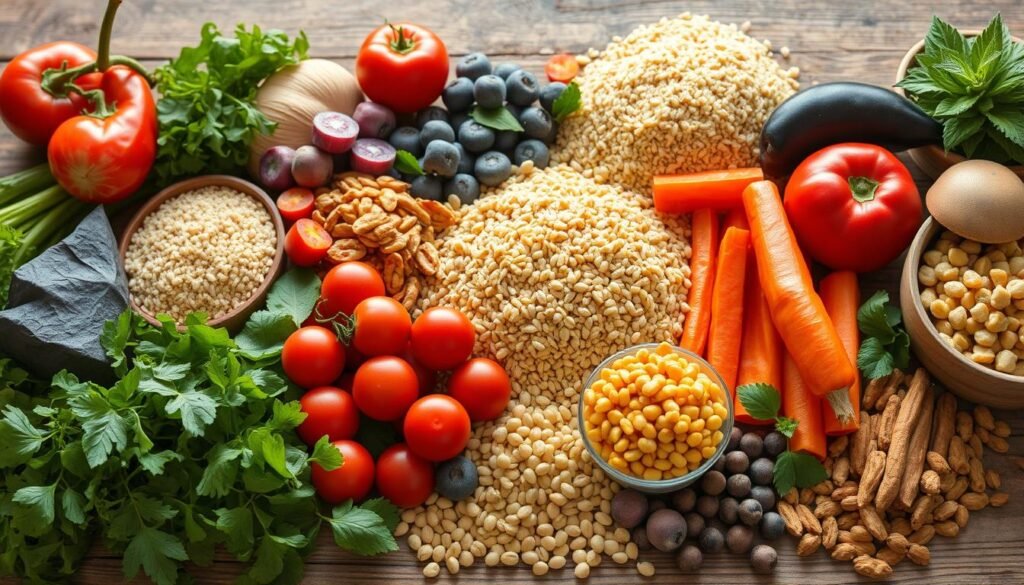
“Whole foods are the key to a balanced, nutrient-rich diet. By focusing on these natural, unprocessed options, you can nourish your body and support your overall health and wellness.”
Navigating the World of Organic Produce
Organic produce is key in clean eating. It boosts your health and wellness. Learning about organic labels and finding affordable options makes it easy to add these foods to your diet.
Why Choose Organic Foods
Organic foods are grown without harmful chemicals. This makes them safer and better for the planet. They also have more antioxidants, which fight off harmful free radicals and support your body.
Reading Organic Labels
Understanding organic labels can be tricky. But knowing the basics helps a lot. Look for the USDA Organic seal for products that meet strict standards. “100% Organic” means all ingredients are organic, while “Organic” means 95% are.
Budget-Friendly Organic Shopping
- Focus on the “Dirty Dozen” – the produce items that tend to have the highest pesticide residues when conventionally grown, such as strawberries, spinach, and apples.
- Take advantage of in-season produce, which is often more affordable and nutrient-dense.
- Explore local farmers’ markets or join a community-supported agriculture (CSA) program to access fresh, organic options at competitive prices.
- Consider buying in bulk or opting for frozen organic produce, which can be just as nutritious as fresh.
Adding organic produce to your diet is a win-win. You get tasty, healthy foods that support your health and well-being.
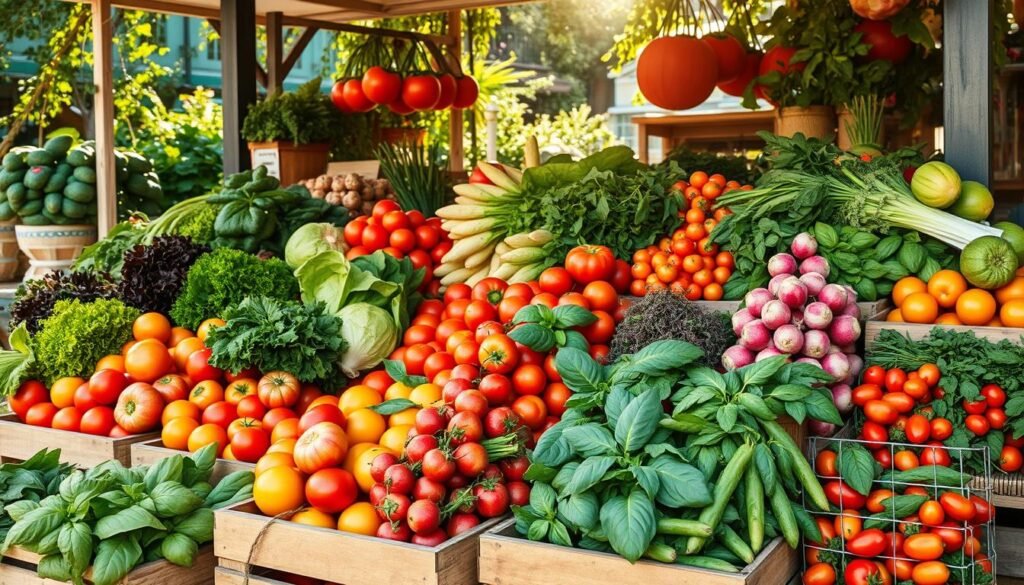
Minimally Processed Foods vs. Refined Options
Choosing between minimally processed and refined foods is key in clean eating. Foods like whole grains, fresh fruits, and lean proteins are at the heart of a healthy diet. They keep their natural nutrients and don’t have added sugars, artificial additives, or unhealthy fats.
Refined foods, on the other hand, are heavily processed. This process removes the fiber-rich bran and germ, leaving behind a product with few nutrients. White bread, pasta, and sugary snacks are examples of refined foods.
| Minimally Processed Foods | Refined Foods |
|---|---|
| Retain natural nutrients | Stripped of natural nutrients |
| Free from added sugars and artificial additives | Often high in added sugars and artificial ingredients |
| Provide fiber and other beneficial compounds | Typically low in fiber and other important nutrients |
| Promote overall health and wellness | Can contribute to weight gain and chronic health issues |
When you’re shopping for minimally processed foods, aim for items with simple, easy-to-read ingredient lists. These clean eating options are essential for nourishing your body and living a healthier life. By choosing whole foods over refined ones, you can greatly improve your health and well-being.
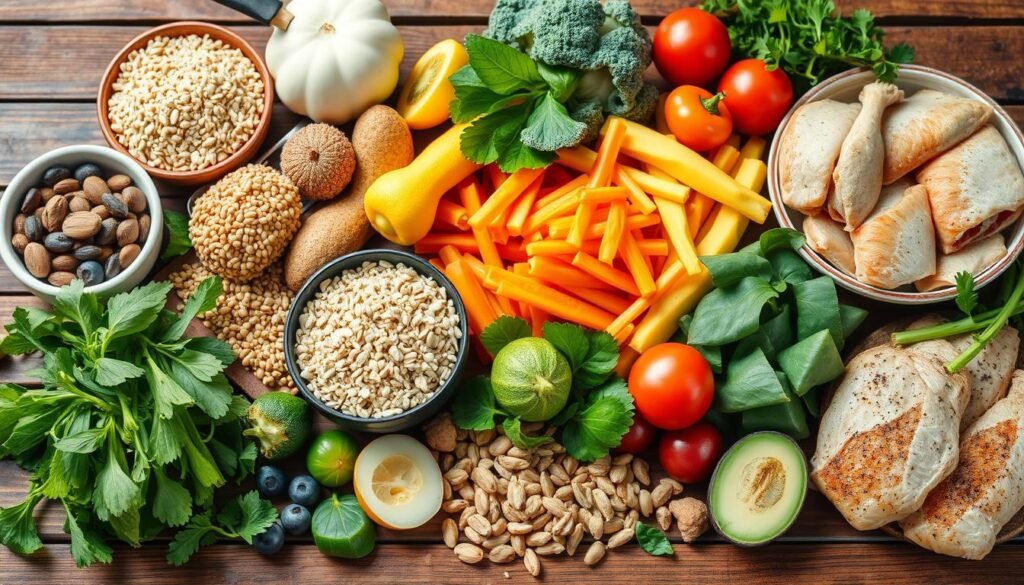
Essential Nutrients in Clean Eating
Starting a clean eating lifestyle means eating foods that are full of nutrients. You need healthy fats, complex carbs, and lean proteins. Let’s look at how to add these important foods to your diet.
Healthy Fats and Their Sources
Not all fats are the same. Clean eating highlights the need for healthy fats. They give you energy, help your brain, and can help with weight control. Good sources are avocados, nuts, seeds, olive oil, and fatty fish like salmon.
Complex Carbohydrates
Carbs are key for energy, but clean eating prefers complex carbohydrates. They’re full of fiber, vitamins, and minerals. Foods like whole grains, legumes, fruits, and veggies are great. They keep you full and satisfied, making them important for a balanced diet.
Lean Protein Options
Protein is vital for muscles, fixing tissues, and energy. Clean eating focuses on lean protein like grilled chicken, turkey, lean beef, eggs, and tofu. These nutrient-dense proteins are easy to add to your meals and snacks.
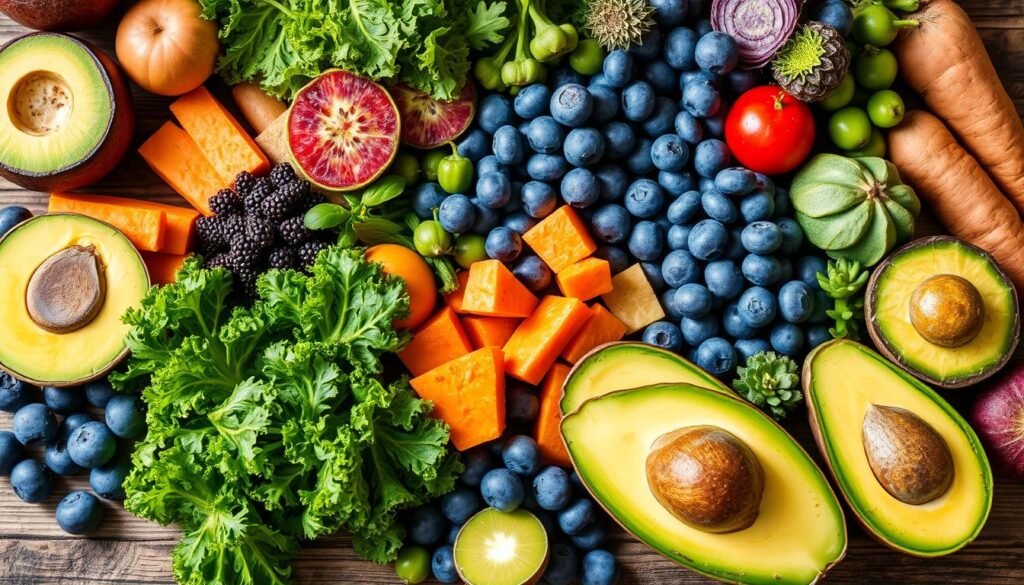
By focusing on these nutrients, you can make a plant-based diet that’s full of energy. It supports your health and clean eating journey.
Building a Clean Eating Meal Plan
Making a clean eating meal plan is a smart move towards a healthier life. It focuses on whole, unprocessed foods, which are key to a clean diet. Eating plant-based and whole foods means you get the nutrients your body needs and enjoy tasty meals.
To make a clean eating meal plan, follow these tips:
- Prioritize Variety: Mix up your whole foods like fresh fruits, veggies, whole grains, legumes, and lean proteins. This ensures you get all the vitamins, minerals, and antioxidants your body needs.
- Balance Macronutrients: Try to have the right mix of carbs, proteins, and healthy fats in each meal. This helps keep your energy up and your body working well.
- Meal Prep for Convenience: Spend some time preparing meals in advance. This way, you’ll have healthy options ready to go all week. It helps avoid the temptation of processed foods.
- Embrace Plant-Based Options: Try out plant-based foods like quinoa, lentils, and tofu. They add variety to your meals and pack a nutritional punch.
By sticking to these tips, you can create a clean eating meal plan. It will feed your body, please your taste buds, and help you stay healthy and well.
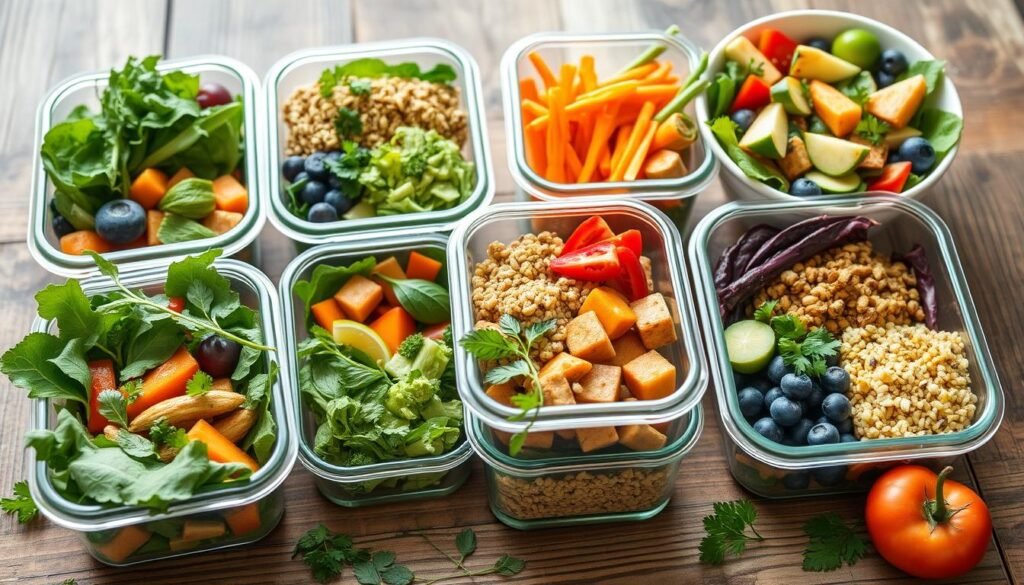
“Eating clean is not about deprivation; it’s about nourishing your body with the wholesome, natural foods it craves.”
Smart Shopping for Natural Ingredients
Starting a clean eating lifestyle means being smart about shopping. You need to find natural ingredients and organic produce. This guide will teach you how to read food labels and spot hidden additives. You’ll learn to make good choices and shop with confidence.
Reading Food Labels
Understanding food labels is key to clean eating. Look for products with simple, natural ingredients. Stay away from long lists of additives, preservatives, and artificial sweeteners. Remember, the ingredients are listed in order of weight, so check the first ones first.
Avoiding Hidden Additives
Even “healthy” foods can have hidden additives. Watch out for high-fructose corn syrup, MSG, and artificial colors. These can harm your health and should be avoided.
Seasonal Shopping Tips
- Buy produce in season for the best taste and freshness.
- Visit local farmers’ markets or co-ops for the freshest organic produce.
- Learn when your favorite fruits and veggies are in season to plan meals.
- Choose frozen organic options when fresh produce is scarce. They keep more nutrients than canned.
By using these smart shopping tips, you can fill your kitchen with natural ingredients and organic produce. This will nourish your body and support your well-being.
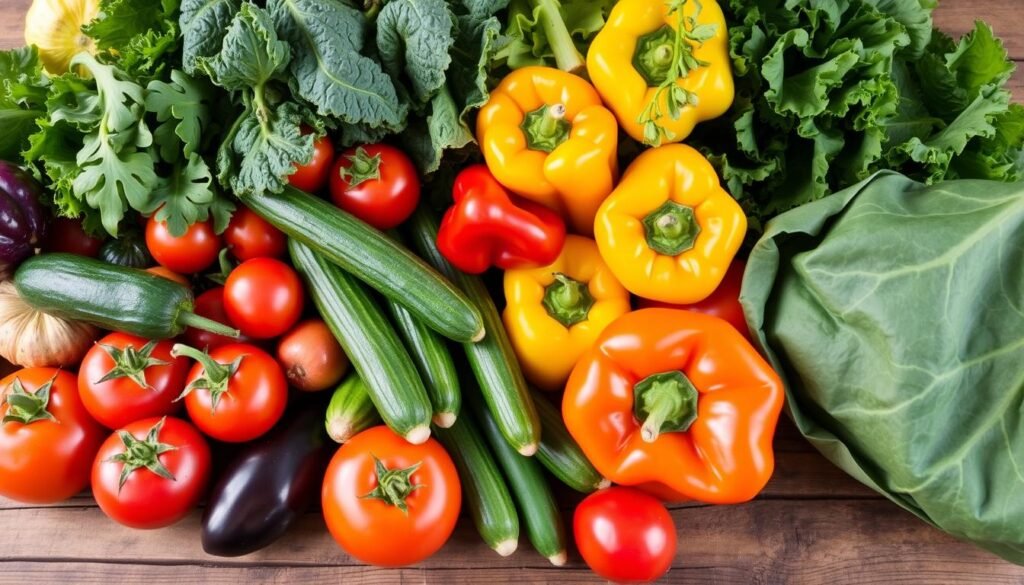
“Eating clean is not about deprivation, it’s about making mindful choices that fuel your body and nourish your soul.”
Common Clean Eating Mistakes to Avoid
Starting a clean eating journey can change your health and wellness for the better. But, watch out for common mistakes that can slow you down. Avoid these errors to keep your diet balanced and lasting.
One big mistake is relying too much on “health” foods. It’s good to eat whole foods and minimally processed items. But, don’t forget to eat a variety of foods. Eating too much of one “superfood” can cause health problems.
Another mistake is ignoring portion sizes. Just because a food is healthy doesn’t mean it has no calories. It’s key to eat mindfully and know how much you’re eating.
- Avoid over-reliance on “health” foods and maintain a diverse, balanced diet.
- Practice portion control, even with clean eating options.
- Understand the true meaning of clean eating and avoid misconceptions.
Lastly, know what clean eating really means. Misunderstandings can cause stress and frustration. Take a flexible and sustainable approach, making small, positive changes to your diet.
“The key to successful clean eating is balance, moderation, and a focus on real, whole foods.”
By avoiding these common mistakes, you can make clean eating a lasting part of your life. This will bring you many health benefits.
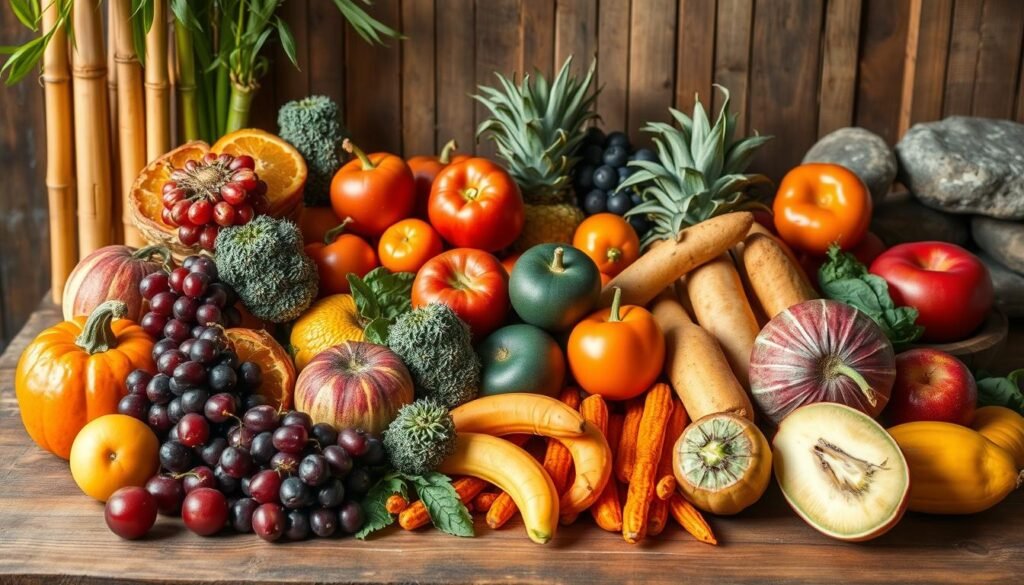
Conclusion
Learning about clean eating can really change your health and happiness. It’s all about eating whole, natural foods. These foods give you the nutrients, fats, and carbs you need every day.
Starting a clean eating life might seem hard at first. But, you can do it by making small, easy changes. Try eating fresh fruits and veggies instead of processed snacks. Look for organic produce too. Every little change helps you get healthier.
Clean eating is more than a quick diet. It’s a way to feed your body right for the long term. Eating whole foods and planning your meals carefully boosts your energy and health. Start this journey to better health and happiness today.
FAQ
What is clean eating, and why is it important?
Clean eating means eating whole, unprocessed foods that are full of nutrients. It’s good for your health because it gives you the vitamins and minerals your body needs.
What are the key principles of clean eating?
Clean eating focuses on eating whole foods and avoiding processed ones. It also means less sugar and unhealthy fats. Try to eat organic and local produce when you can.
What are the benefits of adopting a clean eating lifestyle?
Eating clean can boost your energy and improve digestion. It can also help you manage your weight and lower the risk of serious diseases.
How can I incorporate more whole foods into my diet?
Eat more fresh fruits, veggies, whole grains, lean proteins, and healthy fats. Try to avoid processed and fast foods.
What’s the difference between organic and conventional produce?
Organic produce is grown without harmful chemicals. It often has more nutrients and fewer toxins than conventional produce.
How can I save money on organic foods?
Buy organic for the “Dirty Dozen” produce list. Choose conventional for the “Clean Fifteen” list. This can help you save money.
What are some examples of minimally processed foods?
Good examples include fresh fruits and veggies, whole grains, lean proteins, nuts, seeds, and healthy oils.
How can I identify healthy fats in my diet?
Healthy fats are in avocados, nuts, seeds, and fatty fish. Avoid saturated and trans fats found in processed foods.
What are some common clean eating mistakes to avoid?
Don’t rely too much on “health” foods and watch your portion sizes. Clean eating is about balance and variety in your diet.
How can I create a clean eating meal plan?
Plan meals with whole foods like fruits, veggies, grains, proteins, and healthy fats. Meal prep can make it easier to eat clean.

Hello, I’m Jimmy, founder of Jimmy Cozy Life. I’m here to help you create a home that feels warm, stylish, and balanced. With ideas for decor, celebrations, wellness, and DIY projects, my goal is to share practical tips and a bit of inspiration to make your space truly special.
Disclosure: This post contains affiliate links. If you click and make a purchase, we may receive a small commission at no extra cost to you. The content on this website was developed with assistance from AI.



